





Here, we will look at two beautiful bloomers, Mountain Garland (Clarkia elegans) and Rocket Larkspur (Consolida ambigua), with lovely clusters of blooms. Two plants which are perfect for the neglectful gardener.
Some plants are perfect choices for forgotten areas in the landscape. Is there a spot in your landscape that could use some color, perhaps an area that does not receive as much attention as your other gardens? Planting these two annuals might very well fill that spot without the work it typically takes to plant other annual flower beds.
Mountain garland (Clarkia elegans, syn. C. unguiculata) is commonly referred to simply as "clarkia." Native to California but certainly not limited to California gardens, this plant can be grown across the U.S.
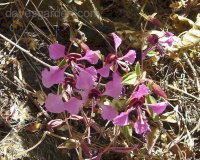 The pastel clusters of blooms on spikes reaching to three feet are often mistaken for rocket larkspur (Consolida ambigua); however, the bloom spikes of mountain garland are purple-black while the larkspur has green spikes. Although naturalized in the United States, rocket larkspur is native to southern Europe.
The pastel clusters of blooms on spikes reaching to three feet are often mistaken for rocket larkspur (Consolida ambigua); however, the bloom spikes of mountain garland are purple-black while the larkspur has green spikes. Although naturalized in the United States, rocket larkspur is native to southern Europe.
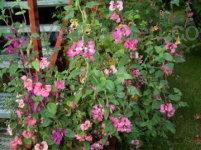 What makes these two plants perfect for the forgotten areas in the landscape is their ability to survive and thrive without any real fuss. Growing conditions for the two are as near to identical as you can get and the color combinations are such that every gardener should be able to find varieties for their favored color palette.
What makes these two plants perfect for the forgotten areas in the landscape is their ability to survive and thrive without any real fuss. Growing conditions for the two are as near to identical as you can get and the color combinations are such that every gardener should be able to find varieties for their favored color palette.
Basic tips for growing mountain garland and rocket larkspur are given below.
When to Plant
Start seeds indoors approximately three weeks before last frost. Set out as soon as possible after last frost to prevent scraggly growth. At my place (zone 8b), the seeds can be scattered in the fall and will sprout in early spring.
Soil
Any well-drained garden soil including gravelly, sandy soil will do. They will not do well in heavy clay soil. Plants may grow in clay; without efforts to amend the soil, the blooms will be sparse and fallen seed may not germinate the following spring.
Water
Water regularly but do not overwater. Base of plants will rot if left to grow in wet areas.
Light
The plants grow best in full sun but will take partial shade though may not bloom as prolifically as if given full sun conditions.
Feeding
Feed with a general purpose fertilizer in spring, compost tea is great, but only at about half the rate of other bedding plants. Too much nitrogen will cause plants to grow leggy with dark foliage and fewer blooms.
Mountain Garland
(Clarkia elegans)
Rocket Larkspur
(Consolida ambigua)
Bloom Color: Pink
Rose/Mauve
Coral/Apricot
Violet/Lavender
White/Near White
*Bloom Period: May to July
Seed Germination: 15 to 30 days
Optimum soil temperature for germination: 65° - 75° F
Sowing depth 1/16 inch
*Scatter & barely cover with soil.
Height: 3 to 4 feetBloom Color: Pink
Rose/Mauve
Light, Medium and Dark Blue
Blue-Violet, Violet/Lavender
White/Near White
*Bloom Period: April to September
Seed Germination: 15 to 30 days
Optimum soil temperature for germination: 50° - 60° F
Sowing depth: 1/8 inch
*Scatter & barely cover with soil.
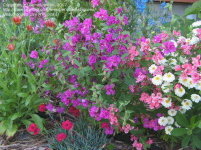
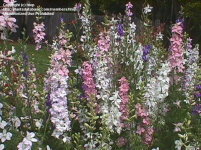
*Although the bloom period above is May to July for mountain garland, it is possible to have blooms from mid-spring until first frost. The same is true for extending the bloom period of rocket larkspur.
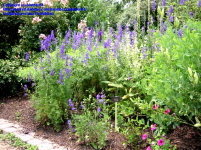

Extras:
•If planted en masse you will be rewarded with a sea of gentle waves when the breeze passes through the blossom-laden spikes.
•Hummingbirds, butterflies and bees will visit your garden regularly.
•Bloom spikes make excellent cut flowers.
•Both are perfect cottage garden additions.
•Present a lovely display along roadsides or property borders.
•Plants will vigorously reseed every year, to the point you may have to pull some out of the garden and dispose of them.
•Perfect for the gardener without a lot of time to spend working in the flower garden but who would still like to enjoy blooms.
CAUTION: Seeds and leaves of the Rocket Larkspur are poisonous if consumed.
Mountain garland and rocket larkspur would be beautiful mixed in a wildflower meadow but if you do not have that much space to plant, consider a nice patch along the side of your garage or around the base of a gazebo. Wherever you decide to plant these flowers, I am certain they will bring many smiles to those who pass by.
Happy Gardening
Photographs
Photo at top right by Dave's Garden member, 2zeus.
All other photo's are by Dave's Garden members; alicewho, bemidjigreen, htop, Kelli, lantana, planter64. Please 'mouse over' photographs for more information.
Sources
Bloom color:
Dave's Garden Plant Files
Seed germination & mature plant size:
Texas A & M University Aggie Horticulture
(Editor's Note: This article was originally published on January 18, 2009. Your comments are welcome, but please be aware that authors of previously published articles may not be able to promptly respond to new questions or comments.)
Copyright © www.100flowers.win Botanic Garden All Rights Reserved